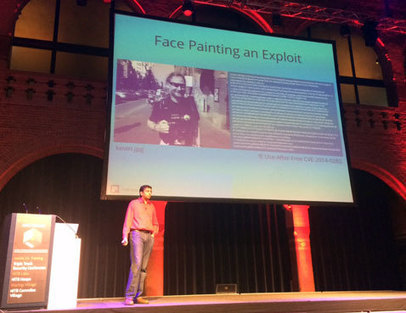Successfully hiding messages in images has already been done, but is it possible to deliver an exploit in one - and run it?
Saumil Shah, founder and CEO of Net-Square, has demonstrated at the Hack in the Box Amsterdam 2015 that it's possible, and has posited that such attacks are more than likely to crop up in the near future, as he can't be the only one who thought about this, tried it and succeeded.
He is not the first one to try and hide exploits in images. But he created Stegosploit, a technology that lets attackers deliver executable JavaScript code via images, and trigger them, too.
The technology opens the door for attacks executed as simply as pointing users to sites containing a booby-trapped image or delivering the image via email. By virtue of simply viewing the image, the exploit code is triggered and can deliver malware on the victim's computer.
"A single file can be rendered as a perfectly valid HTML file, executed as a perfectly valid Javascript file, and displayed as a perfectly valid image, all at the same time," he explains.
"Stegosploit is the result of malicious exploit code hidden within pixels of the image carrying it. The image however, is a multi format container, which also contains the code required to decode the steganographically encoded pixels to execute the exploit."
This type of attack won't show in network traffic, he pointed out, be invisible to the naked eye, and the image will "autorun" in the browser.
In order to make the attack payload look harmless and not trigger defenses, Shah split it into two: dangerous pixel data (exploit code), and a safe decoder.
Via Gust MEES



 Your new post is loading...
Your new post is loading...








Successfully hiding messages in images has already been done, but is it possible to deliver an exploit in one - and run it?
Saumil Shah, founder and CEO of Net-Square, has demonstrated at the Hack in the Box Amsterdam 2015 that it's possible, and has posited that such attacks are more than likely to crop up in the near future, as he can't be the only one who thought about this, tried it and succeeded.
He is not the first one to try and hide exploits in images. But he created Stegosploit, a technology that lets attackers deliver executable JavaScript code via images, and trigger them, too.
The technology opens the door for attacks executed as simply as pointing users to sites containing a booby-trapped image or delivering the image via email. By virtue of simply viewing the image, the exploit code is triggered and can deliver malware on the victim's computer.
"A single file can be rendered as a perfectly valid HTML file, executed as a perfectly valid Javascript file, and displayed as a perfectly valid image, all at the same time," he explains.
"Stegosploit is the result of malicious exploit code hidden within pixels of the image carrying it. The image however, is a multi format container, which also contains the code required to decode the steganographically encoded pixels to execute the exploit."
This type of attack won't show in network traffic, he pointed out, be invisible to the naked eye, and the image will "autorun" in the browser.
In order to make the attack payload look harmless and not trigger defenses, Shah split it into two: dangerous pixel data (exploit code), and a safe decoder.